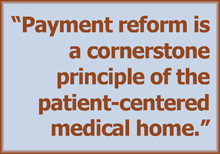Synopsis
The medical home has been promoted by many experts as a model for delivering comprehensive, coordinated, patient-centered health care. In interviews with leaders at 26 demonstration sites around the country where the patient-centered medical home is being pilot-tested, researchers found substantial diversity in terms of size, scope, and design. Most of the projects use a payment approach that combines fee-for-service payments with a fixed, monthly case management fee and bonuses based on clinical performance. Future research should focus on evaluation plans, as interest in the model grows.
 The Issue
The Issue
The primary care system—beset with a fee-for-service reimbursement mechanism that rewards quantity over quality, declining numbers of providers, high and rising per-capita costs, and compromised quality—has reached a critical crossroads, say many industry experts. The patient-centered medical home model has been touted as a potential model for reforming the delivery system and addressing many of these flaws. However, despite great interest in the patient-centered medical home, there is little available comparative information on the various demonstration projects around the country that are testing the approach. Researchers from Harvard Medical School interviewed leaders at 26 demonstration sites in 18 states about payment structure, practice transformation, practice requirements, and other characteristics.
Key Findings
- The researchers identified two models for transforming the way practices provide care to their patients: the consultative model, in which external facilitators are hired to assess and transform care processes, and quality improvement collaboratives, many of which focus on implementing the chronic care model, focusing on conditions such as asthma and diabetes.
- Most of the demonstrations have adopted the "three-part" payment model: fee-for-service payments, a fixed, monthly case management fee, and potential bonuses based on clinical performance.
- Upfront funding for practice transformation was available in over half of the demonstrations, ranging from small lump-sum payments of $1,000 to $6,000 per practice to grants of over $100,000 intended for infrastructure investments.
- The monthly fixed fees ranged from $0.50 to $9, yielding $720 to $91,146 per physician, with a median of $22,834 in additional revenue per physician annually.
-
About 60 percent of the demonstration practices had not yet developed plans for conducting an evaluation. When practices did have evaluation plans, they often had not yet selected specific measures or other assessment tools.
Addressing the Problem
The substantial diversity in the size, scope, design, and concept of the demonstration pilots "suggests an urgent need to incorporate evaluation in programs' designs," the authors conclude. Evaluations are needed to determine the impact on costs and utilization; quality of care as measured by patient experiences, processes, and outcomes; and physician and staff experiences. Yet, less than half of the programs had well-specified evaluation plans, and many had neither secured funding to support a robust evaluation nor adequately identified control groups with which to compare the demonstrations. Because of the upfront investments required, adoption of the medical home approach may not necessarily lead to immediate direct cost savings, the authors say. But wider use of this rational model for delivering health care is likely to help decrease the rate of cost growth in the future and promote better patient experience and quality outcomes.
About the Study
The authors interviewed key participants at 26 demonstration projects in 18 states, which account for 14,000 physicians caring for nearly 5 million patients. The interviews took place between March and August 2009. Eligible projects were identified through literature review, database searches, and Internet searches, and through correspondence with experts in the field. Out of 94 demonstrations identified, 26 met the following criteria: external payment reform, currently active or set to start in 2009, and not restricted to a small proportion of patients being cared for in the practice. This research was supported by The Commonwealth Fund, the Agency for Healthcare Research and Quality, and the American Board of Internal Medicine Foundation.
Bottom Line
Researchers found substantial diversity among patient-centered medical home pilot projects, although most employed a payment model that included fee-for-service payments, a fixed, monthly case management fee, and potential bonuses based on clinical performance. Well-designed evaluation plans will be crucial to understanding whether this model of care delivers on its potential.


